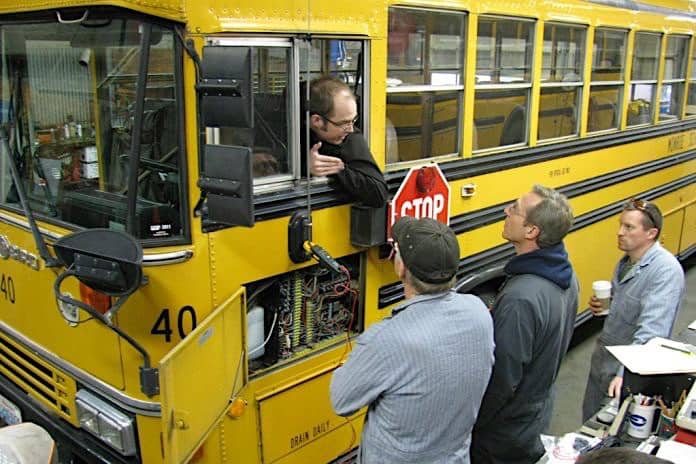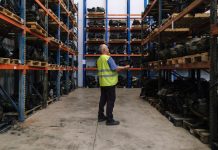It’s a great time to be a mechanic in the school bus industry, as roles in the garage are changing alongside new technology. The power of Wi-Fi and telematics that monitor engine performance and provide diagnostics when the bus is anywhere on route gives school bus technicians a major advantage compared to old-school, wait-and-see troubleshooting.
Diagnostics can be difficult if the tools are not available, but now with vehicle manufacturers integrating telematics into their diagnostic platform, school bus technicians and fleet operators can stay one step ahead of unexpected and costly breakdowns. We asked the leaders in school bus telematics integration a few common questions on how their systems will affect technicians and fleet operators.
 Bill BrintonThis week, we feature Zonar Systems, which partners with Thomas Built Buses to offer vehicle telematics that features diagnostics and vehicle location along with RFID-based student tracking, Electronic Vehicle Inspection Reporting. We spoke with Bill Brinton, co-founder and senior vice president of pupil transportation, and discussed how telematics is transforming the industry, especially in the bus garage.
Bill BrintonThis week, we feature Zonar Systems, which partners with Thomas Built Buses to offer vehicle telematics that features diagnostics and vehicle location along with RFID-based student tracking, Electronic Vehicle Inspection Reporting. We spoke with Bill Brinton, co-founder and senior vice president of pupil transportation, and discussed how telematics is transforming the industry, especially in the bus garage.
STN: How is Zonar V3 Telematics Platform poised to assist school bus technicians with today’s technology?
Brinton: A technician without a telematics system doesn’t have any knowledge of what a bus needs other than what a driver says is going on until he or she plugs into a bus’ engine control unit to read its diagnostics and/or opens up the hood.
This approach can lead to preventable inconveniences and cost prohibitive practices. If a fault code lights up on a bus driver’s dashboard, he/or she will likely be instructed to pull the bus to the side of the road and wait for a technician to arrive to identify and fix the problem as well as have a second bus come to continue the original bus’ route. Upon plugging into the bus, the technician may still have to return to the maintenance garage to get the appropriate parts or order for a tow.
With Zonar’s V3 Telematics that is directly connected to the bus engine control unit (ECU) to access vehicle diagnostic and electronic inspection data, technicians can from the maintenance garage receive fault codes from buses, often before the driver is aware of a problem. Real-time fault code descriptions and vehicle performance data help the technician schedule shop time and maintenance resources to increase school bus uptime a keep up with preventative and active maintenance.
In the event, there is an issue with a bus the technician can identify what course of action the bus driver can take. The driver may be able to safely complete his or her route. The issue could also be something the driver can fix. And if the driver does need to pull over the technician will already know what is wrong with the bus allowing him or her to bring appropriate parts or take other timely actions.
Monitoring and collecting data on engine diagnostics has gone on for years, but using it to prevent breakdowns before they happen is gaining major ground. Just one unplanned road call costs more to a company than an entire telematics system costs for three years. Predictive maintenance can help technicians maintains equipment with minor repair costs, scheduling the repair based on the priority of the vehicle’s problem.
Telematics devices can capture diagnostic trouble codes as well as monitor engine hours, odometer and idle time. Data can then be analyzed to determine trends, like which make/model has specific failures and how those makes/models compare to others. Telematics can improve preventive maintenance plans, but can also affect purchasing decisions. Eventually, the technology will be available to mine this data for patterns that can determine future maintenance issues.
Technician positions are evolving from being someone with automotive repair knowledge to a highly technical skill position that combines automotive repair with computer and analytic skills. Our V3 goes beyond vehicle diagnostic and electronic inspection data for maintenance and efficiency. It can also improve driver performance with vehicle stops, speeds, routes, excessive idling, geo-fence crossings and fuel efficiency reporting.
For all these reasons and more Thomas Built Buses announced in November of 2015 that the V3 would be standard on all new Thomas Built Buses as of late 2016. Further evolving a technician’s traditional role is the industry adoption of telematics as well as the added capabilities provided by the Zonar V3.
STN: With security concerns using Wi-Fi are there any safeguards in place to protect data?
Brinton: As vehicles increasingly incorporate in-vehicle computer systems including those that are WiFi enabled, cyber-security is among the industry’s top priorities and the auto and trucking industries are working relentlessly to enhance vehicle security features. This is an industry-wide issue.
Zonar is committed to ensuring the security of its devices. From day one of any vehicle installation, Zonar works to ensure our technology is secure and compatible with the internal computer systems of the customer vehicles.
Zonar has end-to-end policy and process to ensure secure management of client fleet data and a system of checks and balances in place to identify anomalies and avoid data corruption. Additionally, with our V3 we ensure high availability, load balancing, and internal redundancy resulting in high levels of system uptime and ensuring that clients have access to their data when they want it. No system is ever going to be 100% secure but by following best practice policy and processes, you can safeguard your fleet and be in a readiness position to handle any potential incidents.
STN: What questions should the school bus fleet operator ask when purchasing your system?
Brinton: First and foremost, any school bus fleet operator needs to ask, “Will my system make my fleet safer, improve maintenance and reduce fuel emissions?” Because with Zonar, the answer to all four is yes. Additionally, questions other that are helpful when making a purchase decision include:
- • What features do I need in an onboard telematics solution?
Zonar provides GPS tracking, engine fault code data capture, driver performance reporting, onboard event recording, speed and safety monitoring and automated fuel tax reporting. - • Can the telematics system integrate or provide data to our other operational systems?
Zonar’s V3 has an open API for just such requests. - • Is the solution scalable and can it grow and change as my needs change?
Your needs today may not be the same as your needs tomorrow. If you are just starting out with school bus fleet telematics, you will want to find a solution that is easy to implement, simple to use and highly scalable to meet your needs as you expand. - • Does the provider understand my business?
Since its inception, Zonar has been working with school districts and is now on one out of every three school buses in the country. A vendor that takes the time to understand your business rather than a one-size-fits-all approach is better positioned to help you create a solution specific to your needs and to help suggest new improvements in the future. It is the difference between a consulting partner and a simple supplier. Customer-focused companies like Zonar use flexible business practices that start with you. They listen to your needs before discussing the solution. They work to understand the reasoning behind your needs to uncover areas where additional value can be created. They tailor the solution to meet best your intended goals. - • Can the provider support me for the long-term?
Zonar has been in the business for almost 15 years. Selecting and implementing an onboard computing and telematics system is a major investment in time, resources, and money. There are many fleet telematics providers to choose from and more are being created each year. Aside from technology solutions and customer support, you want to work with an established provider that is available to help improve your business for the long-term.
You should understand how and when the company was established. Learn how the technology was developed, where the company has been and their plans for the future. Ensure the provider is financially sound and management has the business expertise to help ensure stability in the future.
Lastly, conduct due diligence by speaking with reference fleets about their experience with the vendor and in the final stages of the decision process, request a site visit to meet company leaders, staff and see facilities first hand. Taking the time to conduct a thorough vendor review to make sure you are selecting the best partner for your operation will pay off in increased efficiency and cost savings for years to come.
With school buses, the number one priority now and always is transporting children to and from school as safely as possible. Zonar telematics which is on one out of every three school buses nationwide plays an important role in ensuring buses are operating in the safest manner possible.
STN: Thank you.


















